A Global Perspective on Local Sea Level Changes
Abstract
1. Introduction
2. Earlier Work on Mean Sea Level
2.1. General
2.2. Global Sea Level Budget
2.3. Observations of Mean Sea Level
2.4. Projected Mean Sea Level
3. Data and Methods
3.1. Data
- Latest year in the dataset not earlier than 2015, this being a compromise between the desire to have data up to 2020 and the desire to have as many locations included as possible
- Data available over a period of at least 60 years
- At least 80% of the years in the range with data available
3.2. Regression Models
3.3. Statistical Testing
3.4. Definition of the Rate of Sea Level Rise
3.5. Comparison to Projections by the IPCC
4. Results
4.1. PSMSL Data
4.2. GLOSS Data
4.3. Comparison of GLOSS and PSMSL
4.4. Comparison of Rate of Sea Level Rise in PSMSL and IPCC
5. Discussion
6. Conclusions
Author Contributions
Funding
Data Availability Statement
Acknowledgments
Conflicts of Interest
References
- Dutch Expertise Network on Flood Protection (ENW). Fundamentals of Flood Protection. Available online: https://www.enwinfo.nl/publish/pages/183541/grondslagenen-lowresspread3-v_3.pdf (accessed on 4 May 2023).
- UK Government Environment Agency. Flood Risk Assessments: Climate Change Allowances. Available online: https://www.gov.uk/guidance/flood-risk-assessments-climate-change-allowances (accessed on 4 May 2023).
- US Army Corps of Engineers. USACE Climate Action Plan. Available online: https://usace.contentdm.oclc.org/digital/collection/p16021coll11/id/5381 (accessed on 4 May 2023).
- Parker, A.; Ollier, C.D. Coastal Planning Should Be Based on Proven Sea Level Data. Ocean Coast. Manag. 2016, 124, 1–9. [Google Scholar] [CrossRef]
- Voortman, H.G.; Veendorp, M. Robust Flood Defences in a Changing Environment; Nishijima, K., Ed.; CRC Press: Boca Raton, FL, USA, 2011. [Google Scholar]
- Voortman, H.G.; Vrijling, J.K. Optimal Design of Flood Defence Systems in a Changing Climate. Heron 2004, 49, 75–94. [Google Scholar]
- Voortman, H.G.; Van der Kolk, H. Adaptive Design as an Answer to Climate Uncertainty. In Proceedings of the 22nd European Safety and Reliability Conference ESREL, Amsterdam, The Netherlands, 29 September–2 October 2013; pp. 3303–3309. [Google Scholar]
- Kopp, R.E.; Garner, G.G.; Hermans, T.H.J.; Jha, S.; Kumar, P.; Reedy, A.; Slangen, A.B.A.; Turilli, M.; Edwards, T.L.; Gregory, J.M.; et al. The Framework for Assessing Changes To Sea-level (FACTS) v1.0: A platform for characterizing parametric and structural uncertainty in future global, relative, and extreme sea-level change. Geosci. Model Dev. 2023, 16, 7461–7489. [Google Scholar] [CrossRef]
- Fox-Kemper, B.; Hewitt, H.T.; Xiao, C.; Aðalgeirsdóttir, G.; Drijfhout, S.S.; Edwards, T.L.; Golledge, N.R.; Hemer, M.; Kopp, R.E.; Krinner, G.; et al. Ocean, Cryosphere, and Sea Level Change. In Climate Change 2021: The Physical Science Basis. Contribution of Working Group I to the Sixth Assessment Report of the Intergovernmental Panel on Climate Change; Masson-Delmotte, V., Zhai, P., Pirani, A., Connors, S.L., Péan, C., Berger, S., Caud, N., Chen, Y., Goldfarb, L., Gomis, M., et al., Eds.; Cambridge University Press: Cambridge, UK; New York, NY, USA, 2021; pp. 1211–1362. [Google Scholar]
- NASA. NASA Sea Level Projection Tool; NASA: Washington, DC, USA, 2023. [Google Scholar]
- Holgate, S.J.; Matthews, A.; Woodworth, P.L.; Rickards, L.J.; Tamisiea, M.E.; Bradshaw, E.; Foden, P.R.; Gordon, K.M.; Jevrejeva, S.; Pugh, J. New Data Systems and Products at the Permanent Service for Mean Sea Level. J. Coast. Res. 2013, 29, 493–504. [Google Scholar]
- Merrifield, M.; Aarup, T.; Allen, A.; Aman, A.; Caldwell, P.; Bradshaw, E.; Fernandes, R.M.S.; Hayashibara, H.; Hernandez, F.; Kilonsky, B. The Global Sea Level Observing System (GLOSS). In Proceedings of the OceanObs’09: Sustained Ocean Observations and Information for Society, Venice, Italy, 21–25 September 2009; Volume 2. [Google Scholar]
- Kopp, R.E.; Horton, R.M.; Little, C.M.; Mitrovica, J.X.; Oppenheimer, M.; Rasmussen, D.J.; Strauss, B.H.; Tebaldi, C. Probabilistic 21st and 22nd Century Sea-level Projections at a Global Network of Tide-gauge Sites. Earth’s Future 2014, 2, 383–406. [Google Scholar] [CrossRef]
- IPCC. AR5 Climate Change 2013: The Physical Science Basis; IPCC: Geneva, Switzerland, 2013. [Google Scholar]
- Oppenheimer, M.; Glavovic, B.C.; Hinkel, J.; Van de Wal, R.S.W.; Magnan, A.K.; Abd-Elgawad, A.; Cai, R.; Cifuentes-Jara, M.; DeConto, R.M.; Ghosh, T.; et al. Sea Level Rise and Implications for Low-Lying Islands, Coasts and Communities. In The Ocean and Cryosphere in a Changing Climate: Special Report of the Intergovernmental Panel on Climate Change; Cambridge University Press: Cambridge, UK, 2022; pp. 321–446. [Google Scholar]
- KNMI. KNMI Climate Scenarios 2014; KNMI: De Bilt, The Netherlands, 2014. [Google Scholar]
- Voortman, H.G. Robust Validation of Trends and Cycles in Sea Level and Tidal Amplitude in the Dutch North Sea. J. Coast. Hydraul. Struct. 2023, 3. [Google Scholar] [CrossRef]
- Keizer, I.; Le Bars, D.; De Valk, C.; Jüling, A.; Van de Wal, R.S.W.; Drijfhout, S.S. The Acceleration of Sea-Level Rise along the Coast of the Netherlands Started in the 1960s. Ocean Sci. 2023, 19, 991–1007. [Google Scholar] [CrossRef]
- Steffelbauer, D.B.; Riva, R.E.M.; Timmermans, J.S.; Kwakkel, J.H.; Bakker, M. Evidence of Regional Sea-Level Rise Acceleration for the North Sea. Environ. Res. Lett. 2022, 17, 074002. [Google Scholar] [CrossRef]
- Le Bars, D.; De Valk, C.; Keizer, I.; Jüling, A.; Van De Wal, R.S.W.; Drijfhout, S.; Lambert, E. Discussion on: Robust Validation of Trends and Cycles in Sea Level and Tidal Amplitude in the Dutch North Sea. J. Coast. Hydraul. Struct. 2025, 5. [Google Scholar] [CrossRef]
- Munk, W. Twentieth Century Sea Level: An Enigma. Proc. Natl. Acad. Sci. USA 2002, 99, 6550–6555. [Google Scholar] [CrossRef] [PubMed]
- Wahl, T. Sea-Level Rise and Storm Surges, Relationship Status: Complicated! Environ. Res. Lett. 2017, 12, 111001. [Google Scholar] [CrossRef]
- Church, J.A.; White, N.J.; Konikow, L.F.; Domingues, C.M.; Cogley, J.G.; Rignot, E.; Gregory, J.M.; Van den Broeke, M.R.; Monaghan, A.; Velicogna, I. Revisiting the Earth’s Sea-Level and Energy Budgets from 1961 to 2008. Geophys. Res. Lett. 2011, 38, L18601. [Google Scholar] [CrossRef]
- Dangendorf, S.; Hay, C.; Calafat, F.M.; Marcos, M.; Piecuch, C.G.; Berk, K.; Jensen, J. Persistent Acceleration in Global Sea-Level Rise since the 1960s. Nat. Clim. Chang. 2019, 9, 705–710. [Google Scholar] [CrossRef]
- Holgate, S.J.; Woodworth, P.L. Evidence for Enhanced Coastal Sea Level Rise during the 1990s. Geophys. Res. Lett. 2004, 31. [Google Scholar] [CrossRef]
- Mawdsley, R.J.; Haigh, I.D.; Wells, N.C. Global Secular Changes in Different Tidal High Water, Low Water and Ra Nge Levels. Earth’s Future 2015, 3, 66–81. [Google Scholar] [CrossRef]
- Mawdsley, R.J.; Haigh, I.D. Global Changes and Variability in Extreme Sea Levels from 1846–2014. Ph.D. Thesis, University of Southampton, Southampton, UK, 2016. [Google Scholar]
- Pan, H.; Lv, X. Is There a Quasi 60-Year Oscillation in Global Tides? Cont. Shelf Res. 2021, 222, 104433. [Google Scholar] [CrossRef]
- Rovere, A.; Stocchi, P.; Vacchi, M. Eustatic and Relative Sea Level Changes. Curr. Clim. Change Rep. 2016, 2, 221–231. [Google Scholar] [CrossRef]
- Woodworth, P.L. A World-wide Search for the 11-yr Solar Cycle in Mean Sea-level Records. Geophys. J. R. Astron. Soc. 1985, 80, 743–755. [Google Scholar] [CrossRef]
- Frederikse, T.; Landerer, F.; Caron, L.; Adhikari, S.; Parkes, D.; Humphrey, V.W.; Dangendorf, S.; Hogarth, P.; Zanna, L.; Cheng, L.; et al. The Causes of Sea-Level Rise since 1900. Nature 2020, 584, 393–397. [Google Scholar] [CrossRef]
- Amin, M. Changing Mean Sea Level and Tidal Constants on the West Coast of Australia. Mar. Freshw. Res. 1993, 44, 911–925. [Google Scholar] [CrossRef]
- Blaha, J.P. Fluctuations of Monthly Sea Level as Related to the Intensity of the Gulf Stream from Key West to Norfolk. J. Geophys. Res. Ocean. 1984, 89, 8033–8042. [Google Scholar] [CrossRef]
- Cazenave, A.; Moreira, L. Contemporary Sea-Level Changes from Global to Local Scales: A Review. Proc. R. Soc. A 2022, 478, 20220049. [Google Scholar] [CrossRef]
- Cherniawsky, J.Y.; Foreman, M.G.G.; Kang, S.K.; Scharroo, R.; Eert, A.J. 18.6-Year Lunar Nodal Tides from Altimeter Data. Cont. Shelf Res. 2010, 30, 575–587. [Google Scholar] [CrossRef]
- Dangendorf, S.; Calafat, F.M.; Arns, A.; Wahl, T.; Haigh, I.D.; Jensen, J. Mean Sea Level Variability in the North Sea: Processes and Implications. J. Geophys. Res. Ocean. 2014, 119, 6820–6841. [Google Scholar] [CrossRef]
- Dangendorf, S.; Frederikse, T.; Chafik, L.; Klinck, J.M.; Ezer, T.; Hamlington, B.D. Data-Driven Reconstruction Reveals Large-Scale Ocean Circulation Control on Coastal Sea Level. Nat. Clim. Change 2021, 11, 514–520. [Google Scholar] [CrossRef]
- Stolte, W.; Baart, F.; Muis, S.; Hijma, M.P.; Taal, M.; Le Bars, D.; Drijfhout, S. Zeespiegelmonitor 2022; Deltares: Delft, The Netherlands, 2023. [Google Scholar]
- Douglas, B.C. Global Sea Level Acceleration. J. Geophys. Res. Ocean. 1992, 97, 12699–12706. [Google Scholar] [CrossRef]
- Führböter, A. Changes of the Tidal Water Levels at the German North Sea Coast. Helgoländer Meeresunters. 1989, 43, 325–332. [Google Scholar] [CrossRef]
- Hagen, R.; Plüß, A.; Jänicke, L.; Freund, J.; Jensen, J.; Kösters, F. A Combined Modeling and Measurement Approach to Assess the Nodal Tide Modulation in the North Sea. J. Geophys. Res. Ocean. 2021, 126, e2020JC016364. [Google Scholar] [CrossRef]
- Hagen, R.; Winter, C.; Kösters, F. Changes in Tidal Asymmetry in the German Wadden Sea. Ocean Dyn. 2022, 72, 325–340. [Google Scholar] [CrossRef]
- Haigh, I.D.; Nicholls, R.J.; Wells, N. Assessing Changes in Extreme Sea Levels: Application to the English Channel, 1900–2006. Cont. Shelf Res. 2010, 30, 1042–1055. [Google Scholar] [CrossRef]
- Jänicke, L. Assessing Changes of Tidal Dynamics in the North Sea: An Investigation of the Temporal and Spatial Developments Between 1958 and 2014. 2022. Available online: https://agupubs.onlinelibrary.wiley.com/doi/full/10.1029/2020JC016456 (accessed on 9 May 2023).
- Jänicke, L.; Ebener, A.; Dangendorf, S.; Arns, A.; Schindelegger, M.; Niehüser, S.; Haigh, I.D.; Woodworth, P.L.; Jensen, J. Assessment of Tidal Range Changes in the North Sea From 1958 to 2014. J. Geophys. Res. Ocean. 2021, 126, e2020JC016456. [Google Scholar] [CrossRef]
- Le Bars, D.; De Vries, H.; Drijfhout, S. Sea Level Rise and Its Spatial Variations, KNMI-Report TR-372. 2019. Available online: https://www.knmi.nl/kennis-en-datacentrum/publicatie/sea-level-rise-and-its-spatial-variations (accessed on 15 August 2025).
- Parker, A. Oscillations of Sea Level Rise along the Atlantic Coast of North America North of Cape Hatteras. Nat. Hazards 2013, 65, 991–997. [Google Scholar] [CrossRef]
- Proudman, J.; Doodson, A.T. The Principal Constituent of the Tides of the North Sea. Philos. Trans. R. Soc. London. Ser. A Contain. Pap. A Math. Or Phys. 1924, 224, 185–219. [Google Scholar]
- Rasheed, A.S.; Chua, V.P. Secular Trends in Tidal Parameters along the Coast of Japan. Atmos.-Ocean 2014, 52, 155–168. [Google Scholar] [CrossRef]
- Ray, R.D. Secular Changes of the M2 Tide in the Gulf of Maine. Cont. Shelf Res. 2006, 26, 422–427. [Google Scholar] [CrossRef]
- Ray, R.D. On Seasonal Variability of the M 2 Tide. Ocean Sci. 2022, 18, 1073–1079. [Google Scholar] [CrossRef]
- Ray, R.D.; Merrifield, M.A. The Semiannual and 4.4-Year Modulations of Extreme High Tides. J. Geophys. Res. Ocean. 2019, 124, 5907–5922. [Google Scholar] [CrossRef]
- Ross, A.C.; Najjar, R.G.; Li, M.; Lee, S.B.; Zhang, F.; Liu, W. Fingerprints of Sea Level Rise on Changing Tides in the Chesapeake and Delaware Bays. J. Geophys. Res. Ocean. 2017, 122, 8102–8125. [Google Scholar] [CrossRef]
- Rossiter, J.R. An Analysis of Annual Sea Level Variations in European Waters. Geophys. J. Int. 1967, 12, 259–299. [Google Scholar] [CrossRef]
- Sallenger, A.H.; Doran, K.S.; Howd, P.A. Hotspot of Accelerated Sea-Level Rise on the Atlantic Coast of North America. Nat. Clim Change 2012, 2, 884–888. [Google Scholar] [CrossRef]
- Shaw, A.G.P.; Tsimplis, M.N. The 18.6 Yr Nodal Modulation in the Tides of Southern European Coasts. Cont. Shelf Res. 2010, 30, 138–151. [Google Scholar] [CrossRef]
- Sloss, C.R.; Murray-Wallace, C.V.; Jones, B.G. Holocene Sea-Level Change on the Southeast Coast of Australia: A Review. Holocene 2007, 17, 999–1014. [Google Scholar] [CrossRef]
- Stammer, D.; Cazenave, A.; Ponte, R.M.; Tamisiea, M.E. Causes for Contemporary Regional Sea Level Changes. Annu. Rev. Mar. Sci. 2012, 5, 21–46. [Google Scholar] [CrossRef]
- Torres, R.R.; Tsimplis, M.N. Tides and Long-Term Modulations in the Caribbean Sea. J. Geophys. Res. Ocean. 2011, 116, C10022. [Google Scholar] [CrossRef]
- Watson, P.J. Acceleration in US Mean Sea Level? A New Insight Using Improved Tools. J. Coast. Res. 2016, 32, 1247–1261. [Google Scholar] [CrossRef]
- Watson, P.J. Acceleration in European Mean Sea Level? A New Insight Using Improved Tools. J. Coast. Res. 2017, 33, 23–38. [Google Scholar] [CrossRef]
- Woodworth, P.L.; Shaw, S.M.; Blackman, D.L. Secular Trends in Mean Tidal Range around the British Isles and along the Adjacent European Coastline. Geophys. J. Int. 1991, 104, 593–609. [Google Scholar] [CrossRef]
- Woodworth, P.L.; Teferle, F.N.; Bingley, R.M.; Shennan, I.; Williams, S.D.P. Trends in UK Mean Sea Level Revisited. Geophys. J. Int. 2009, 176, 19–30. [Google Scholar] [CrossRef]
- Woodworth, P.L.; White, N.J.; Jevrejeva, S.; Holgate, S.J.; Church, J.A.; Gehrels, W.R. Evidence for the Accelerations of Sea Level on Multi-Decade and Century Timescales. Int. J. Climatol. A J. R. Meteorol. Soc. 2009, 29, 777–789. [Google Scholar] [CrossRef]
- Wöppelmann, G.; Pouvreau, N.; Simon, B. Brest Sea Level Record: A Time Series Construction Back to the Early Eighteenth Century. Ocean Dyn. 2006, 56, 487–497. [Google Scholar] [CrossRef]
- Church, J.A.; White, N.J.; Aarup, T.; Wilson, W.S.; Woodworth, P.L.; Domingues, C.M.; Hunter, J.R.; Lambeck, K. Understanding Global Sea Levels: Past, Present and Future. Sustain. Sci. 2008, 3, 9–22. [Google Scholar] [CrossRef]
- Church, J.A.; White, N.J. A 20th Century Acceleration in Global Sea-Level Rise. Geophys. Res. Lett. 2006, 33, 313–324. [Google Scholar] [CrossRef]
- Church, J.A.; White, N.J. Sea-Level Rise from the Late 19th to the Early 21st Century. Surv. Geophys. 2011, 32, 585–602. [Google Scholar] [CrossRef]
- Frederikse, T.; Riva, R.E.M.; Kleinherenbrink, M.; Wada, Y.; Van den Broeke, M.R.; Marzeion, B. Closing the Sea Level Budget on a Regional Scale: Trends and Variability on the Northwestern European Continental Shelf. Geophys. Res. Lett. 2016, 43, 10864–10872. [Google Scholar] [CrossRef]
- Frederikse, T.; Jevrejeva, S.; Riva, R.E.M.; Dangendorf, S. A Consistent Sea-Level Reconstruction and Its Budget on Basin and Global Scales over 1958–2014. J. Clim. 2018, 31, 1267–1280. [Google Scholar] [CrossRef]
- Wouters, B.; van de Wal, R.S.W. Global Sea-Level Budget 1993–Present. Earth Syst. Sci. Data 2018, 10, 1551–1590. [Google Scholar] [CrossRef]
- Jevrejeva, S.; Matthews, A.; Slangen, A. The Twentieth-Century Sea Level Budget: Recent Progress and Challenges. In Integrative Study of the Mean Sea Level and Its Components; Springer: Berlin/Heidelberg, Germany, 2017; pp. 301–313. [Google Scholar] [CrossRef]
- Wang, J.; Church, J.A.; Zhang, X.; Chen, X. Reconciling Global Mean and Regional Sea Level Change in Projections and Observations. Nat. Commun. 2021, 12, 990. [Google Scholar] [CrossRef] [PubMed]
- White, N.J.; Church, J.A.; Gregory, J.M. Coastal and Global Averaged Sea Level Rise for 1950 to 2000. Geophys. Res. Lett. 2005, 32, L01601. [Google Scholar] [CrossRef]
- Bowman, W. UTide for Python. Version 0.3.0. Available online: https://github.com/wesleybowman/UTide (accessed on 19 June 2025).
- Codiga, D. Unified Tidal Analysis and Prediction Using the UTide Matlab Functions. 2011. Available online: https://www.researchgate.net/publication/280722790_Unified_tidal_analysis_and_prediction_using_the_UTide_Matlab_functions (accessed on 15 August 2025).
- Doodson, A.T. The Harmonic Development of the Tide-Generating Potential. Proc. R. Soc. London. Ser. A Contain. Pap. A Math. Phys. Character 1921, 100, 305–329. [Google Scholar] [CrossRef]
- Pugh, D.; Woodworth, P.L. Sea-Level Science: Understanding Tides, Surges, Tsunamis and Mean Sea-Level Changes; Cambridge University Press: Cambridge, UK, 2014; ISBN 978-1-107-02819-7. [Google Scholar]
- Leuliette, E.W.; Nerem, R.S.; Mitchum, G.T. Calibration of TOPEX/Poseidon and Jason Altimeter Data to Construct a Continuous Record of Mean Sea Level Change. Mar. Geod. 2004, 27, 79–94. [Google Scholar] [CrossRef]
- Nerem, R.S. Measuring Global Mean Sea Level Variations Using TOPEX/POSEIDON Altimeter Data. J. Geophys. Res. Ocean. 1995, 100, 25135–25151. [Google Scholar] [CrossRef]
- Christensen, E.J.; Haines, B.J.; Keihm, S.J.; Morris, C.S.; Norman, R.A.; Purcell, G.H.; Williams, B.G.; Wilson, B.D.; Born, G.H.; Parke, M.E.; et al. Calibration of TOPEX/POSEIDON at Platform Harvest. J. Geophys. Res. Ocean. 1994, 99, 24465–24485. [Google Scholar] [CrossRef]
- Fu, L.-L.; Haines, B.J. The Challenges in Long-Term Altimetry Calibration for Addressing the Problem of Global Sea Level Change. Adv. Space Res. 2013, 51, 1284–1300. [Google Scholar] [CrossRef]
- Ruf, C.S.; Keihm, S.J.; Subramanya, B.; Janssen, M.A. TOPEX/POSEIDON Microwave Radiometer Performance and in-Flight Calibration. J. Geophys. Res. Ocean. 1994, 99, 24915–24926. [Google Scholar] [CrossRef]
- Visser, H.; Dangendorf, S.; Petersen, A.C. A Review of Trend Models Applied to Sea Level Data with Reference to the “Acceleration-Deceleration Debate”. J. Geophys. Res. Ocean. 2015, 120, 3873–3895. [Google Scholar] [CrossRef]
- Slangen, A.B.A.; Haasnoot, M.; Winter, G. Rethinking sea-Level Projections Using Families and Timing Differences. Earth’s Future 2022, 10, e2021EF002576. [Google Scholar] [CrossRef]
- Ott, L.; Longnecker, M. An Introduction to Statistical Methods & Data Analysis, 7th ed.; Cengage Learning: Melbourne, Australia, 2016; ISBN 978-1-305-26947-7. [Google Scholar]
- Akaike, H. A New Look at the Statistical Model Identification. IEEE Trans. Autom. Control 1974, 19, 716–723. [Google Scholar] [CrossRef]
- Schwarz, G. Estimating the Dimension of a Model. Ann. Stat. 1978, 6, 461–464. [Google Scholar] [CrossRef]
- Frederikse, T.; Gerkema, T. Multi-Decadal Variability in Seasonal Mean Sea Level along the North Sea Coast. Ocean Sci. 2018, 14, 1491–1501. [Google Scholar] [CrossRef]
- Bland, J.M.; Altman, D.G. Statistics Notes: Multiple Significance Tests: The Bonferroni Method. BMJ 1995, 310, 170. [Google Scholar] [CrossRef]
- Bonferroni, C. Teoria Statistica Delle Classi e Calcolo Delle Probabilita; R Istituto Superiore di Scienze Economiche e Commericiali di Firenze: Florence, Italy, 1936; Volume 8, pp. 3–62. [Google Scholar]
- Bence, J.R. Analysis of Short Time Series: Correcting for Autocorrelation. Ecology 1995, 76, 628–639. [Google Scholar] [CrossRef]
- Trace-Kleeberg, S.; Haigh, I.D.; Walraven, M.; Gourvenec, S. How Should Storm Surge Barrier Maintenance Strategies Be Changed in Light of Sea-Level Rise? A Case Study. Coast. Eng. 2023, 184, 104336. [Google Scholar] [CrossRef]
- Meinshausen, M.; Nicholls, Z.R.J.; Lewis, J.; Gidden, M.J.; Vogel, E.; Freund, M.; Beyerle, U.; Gessner, C.; Nauels, A.; Bauer, N.; et al. The Shared Socio-Economic Pathway (SSP) Greenhouse Gas Concentrations and Their Extensions to 2500. Geosci. Model Dev. 2020, 13, 3571–3605. [Google Scholar] [CrossRef]
- O’Neill, B.C.; Kriegler, E.; Riahi, K.; Ebi, K.L.; Hallegatte, S.; Carter, T.R.; Mathur, R.; Van Vuuren, D.P. A New Scenario Framework for Climate Change Research: The Concept of Shared Socioeconomic Pathways. Clim. Change 2014, 122, 387–400. [Google Scholar] [CrossRef]
- Burgess, M.G.; Langendorf, R.E.; Ippolito, T.; Pielke, R., Jr. Optimistically Biased Economic Growth Forecasts and Negatively Skewed Annual Variation; Center for Open Science: Charlottesville, VA, USA, 2020. [Google Scholar] [CrossRef]
- Burgess, M.G.; Ritchie, J.; Shapland, J.; Pielke, R., Jr. IPCC Baseline Scenarios Have Over-Projected CO2 Emissions and Economic Growth. Environ. Res. Lett. 2020, 16, 014016. [Google Scholar] [CrossRef]
- Hausfather, Z.; Peters, G.P. Emissions–the ‘Business as Usual’Story Is Misleading. Nature 2020, 577, 618–620. [Google Scholar] [CrossRef] [PubMed]
- Pielke, R., Jr.; Burgess, M.G.; Ritchie, J. Plausible 2005–2050 Emissions Scenarios Project between 2 °C and 3 °C of Warming by 2100. Environ. Res. Lett. 2022, 17, 024027. [Google Scholar] [CrossRef]
- UNFCCC. NDC Synthesis Report; UNFCCC: Bonn, Germany, 2022. [Google Scholar]
- Chen, D.; Rojas, M.; Samset, B.H.; Cobb, K.; Diongue-Niang, A.; Edwards, P.; Emori, S.; Faria, S.H.; Hawkins, E.; Hope, P.; et al. Framing, Context, and Methods. In Climate Change 2021: The Physical Science Basis. Contribution of Working Group I to the Sixth Assessment Report of the Intergovernmental Panel on Climate Change; Masson-Delmotte, V., Zhai, P., Pirani, A., Connors, S.L., Péan, C., Berger, S., Caud, N., Chen, Y., Goldfarb, L., Gomis, M.I., et al., Eds.; Cambridge University Press: Cambridge, UK; New York, NY, USA, 2021; pp. 147–286. [Google Scholar]
- Hinkel, J.; Church, J.A.; Gregory, J.M.; Lambert, E.; Le Cozannet, G.; Lowe, J.; McInnes, K.L.; Nicholls, R.J.; van der Pol, T.D.; van de Wal, R. Meeting User Needs for Sea Level Rise Information: A Decision Analysis Perspective. Earth’s Future 2019, 7, 320–337. [Google Scholar] [CrossRef]
- Jevrejeva, S.; Moore, J.C.; Grinsted, A.; Matthews, A.P.; Spada, G. Trends and Acceleration in Global and Regional Sea Levels since 1807. Glob. Planet. Change 2014, 113, 11–22. [Google Scholar] [CrossRef]
- Hamlington, B.D.; Gardner, A.S.; Ivins, E.; Lenaerts, J.T.M.; Reager, J.T.; Trossman, D.S.; Zaron, E.D.; Adhikari, S.; Arendt, A.; Aschwanden, A.; et al. Understanding of Contemporary Regional Sea-Level Change and the Implications for the Future. Rev. Geophys. 2020, 58, e2019RG000672. [Google Scholar] [CrossRef]
- Wöppelmann, G.; Marcos, M. Vertical Land Motion as a Key to Understanding Sea Level Change and Variability. Rev. Geophys. 2016, 54, 64–92. [Google Scholar] [CrossRef]
- Vecchio, A.; Anzidei, M.; Serpelloni, E. Sea Level Rise Projections up to 2150 in the Northern Mediterranean Coasts. Environ. Res. Lett. 2024, 19, 014050. [Google Scholar] [CrossRef]
- Jin, S.; Zhang, T.Y.; Zou, F. Glacial Density and GIA in Alaska Estimated from ICESat, GPS and GRACE Measurements. JGR Earth Surf. 2017, 122, 76–90. [Google Scholar] [CrossRef]
- Sato, T.; Miura, S.; Sun, W.; Sugano, T.; Freymueller, J.T.; Larsen, C.F.; Ohta, Y.; Fujimoto, H.; Inazu, D.; Motyka, R.J. Gravity and Uplift Rates Observed in Southeast Alaska and Their Comparison with GIA Model Predictions. J. Geophys. Res. 2012, 117, 2011JB008485. [Google Scholar] [CrossRef]
- Nalakurthi, N.S.R.N.; Behera, M.R. Detection of Land Subsidence Using Sentinel-1 Interferometer and Its relationship with Sea-Level-Rise, Groundwater, and Inundation: A Case s Tudy along Mumbai Coastal City. 2022. Available online: https://www.researchsquare.com/article/rs-1392714/v1 (accessed on 7 December 2023).
- Wu, P.-C.; Wei, M.; D’Hondt, S. Subsidence in Coastal Cities Throughout the World Observed by InSAR. Geophys. Res. Lett. 2022, 49, e2022GL098477. [Google Scholar] [CrossRef]
- Hashima, A.; Sato, T. A Megathrust Earthquake Cycle Model for Northeast Japan: Bridging the Mismatch between Geological Uplift and Geodetic Subsidence. Earth Planets Space 2017, 69, 23. [Google Scholar] [CrossRef]
- Nishimura, T. Pre-, Co-, and Post-Seismic Deformation of the 2011 Tohoku-Oki Earthquake and Its Implication to a Paradox in Short-Term and Long-Term Deformation. J. Disaster Res. 2014, 9, 294–302. [Google Scholar] [CrossRef]
- Yuill, B.; Lavoie, D.; Reed, D.J. Understanding Subsidence Processes in Coastal Louisiana. J. Coast. Res. 2009, 10054, 23–36. [Google Scholar] [CrossRef]
- Blum, M.; Rahn, D.; Frederick, B.; Polanco, S. Land Loss in the Mississippi River Delta: Role of Subsidence, Global s Ea-Level Rise, and Coupled Atmospheric and Oceanographic Processes. Glob. Planet. Change 2023, 222, 104048. [Google Scholar] [CrossRef]
- Terzaghi, K.; Peck, R.B.; Mesri, G. Soil Mechanics in Engineering Practice; John Wiley & Sons: Hoboken, NJ, USA, 1996. [Google Scholar]
- Han, S.; Sauber, J.; Pollitz, F.; Ray, R. Sea Level Rise in the Samoan Islands Escalated by Viscoelastic Relaxation After the 2009 Samoa-Tonga Earthquake. JGR Solid Earth 2019, 124, 4142–4156. [Google Scholar] [CrossRef]
- Steffen, H.; Kaufmann, G. Glacial Isostatic Adjustment of Scandinavia and Northwestern Europe and the Radial Viscosity Structure of the Earth’s Mantle. Geophys. J. Int. 2005, 163, 801–812. [Google Scholar] [CrossRef]
- Tsimplis, M.N.; Calafat, F.M.; Marcos, M.; Jordà, G.; Gomis, D.; Fenoglio-Marc, L.; Struglia, M.V.; Josey, S.A.; Chambers, D.P. The Effect of the NAO on Sea Level and on Mass Changes in the Mediterranean Sea. JGR Ocean. 2013, 118, 944–952. [Google Scholar] [CrossRef]
- Babel, M.S.; Gupta, A.D.; Domingo, N.D.S. Land Subsidence: A Consequence of Groundwater Over-Exploitation in Ban Gkok, Thailand—Google Zoeken. Int. Rev. Environ. Strateg. 2006, 6, 307–328. [Google Scholar]
- Olson, K.R.; Kreznor, W. Managing the Chao Phraya River and Delta in Bangkok, Thailand: Flood C Ontrol, Navigation and Land Subsidence Mitigation. Open J. Soil Sci. 2021, 11, 197–215. [Google Scholar] [CrossRef]
- Phien-wej, N.; Giao, P.H.; Nutalaya, P. Land Subsidence in Bangkok, Thailand. Eng. Geol. 2006, 82, 187–201. [Google Scholar] [CrossRef]
- Jirapinyakul, A.; Nudnara, W.; Punwong, P.; Nohall, R.; Englong, A.; Phujareanchaiwon, C.; Yamoah, K.A.; Choowong, M. ENSO May Have Contributed to Sea Level Changes in the Gulf of Thailand during the Late-Holocene. Holocene 2023, 33, 1453–1464. [Google Scholar] [CrossRef]
- Taninpong, P.; Minsan, W.; Thumrongnavasawat, S.; Luangdang, K. Trend Analysis of Sea Level Change in the Gulf of Thailand. Sci. Essence J. 2021, 37, 64–77. [Google Scholar]
- Lambeck, K.; Purcell, A.; Johnston, P.; Nakada, M.; Yokoyama, Y. Water-Load Definition in the Glacio-Hydro-Isostatic Sea-Level Equation. Quat. Sci. Rev. 2003, 22, 309–318. [Google Scholar] [CrossRef]
- Aedo, D.; Cisternas, M.; Melnick, D.; Esparza, C.; Wincklr, P.; Saldaña, B. Decadal Coastal Evolution Spanning the 2010 Maule Earthquake at Isla Santa Maria, Chile: Framing Darwin’s Accounts of Uplift over a Seismic Cycle. Earth Surf. Process. Landf. 2023, 48, 2319–2333. [Google Scholar] [CrossRef]
- Dangendorf, S.; Hendricks, N.; Sun, Q.; Klinck, J.; Ezer, T.; Frederikse, T.; Calafat, F.M.; Wahl, T.; Törnqvist, T.E. Acceleration of U.S. Southeast and Gulf Coast Sea-Level Rise Amplified by Internal Climate Variability. Nat. Commun. 2023, 14, 1935. [Google Scholar] [CrossRef]


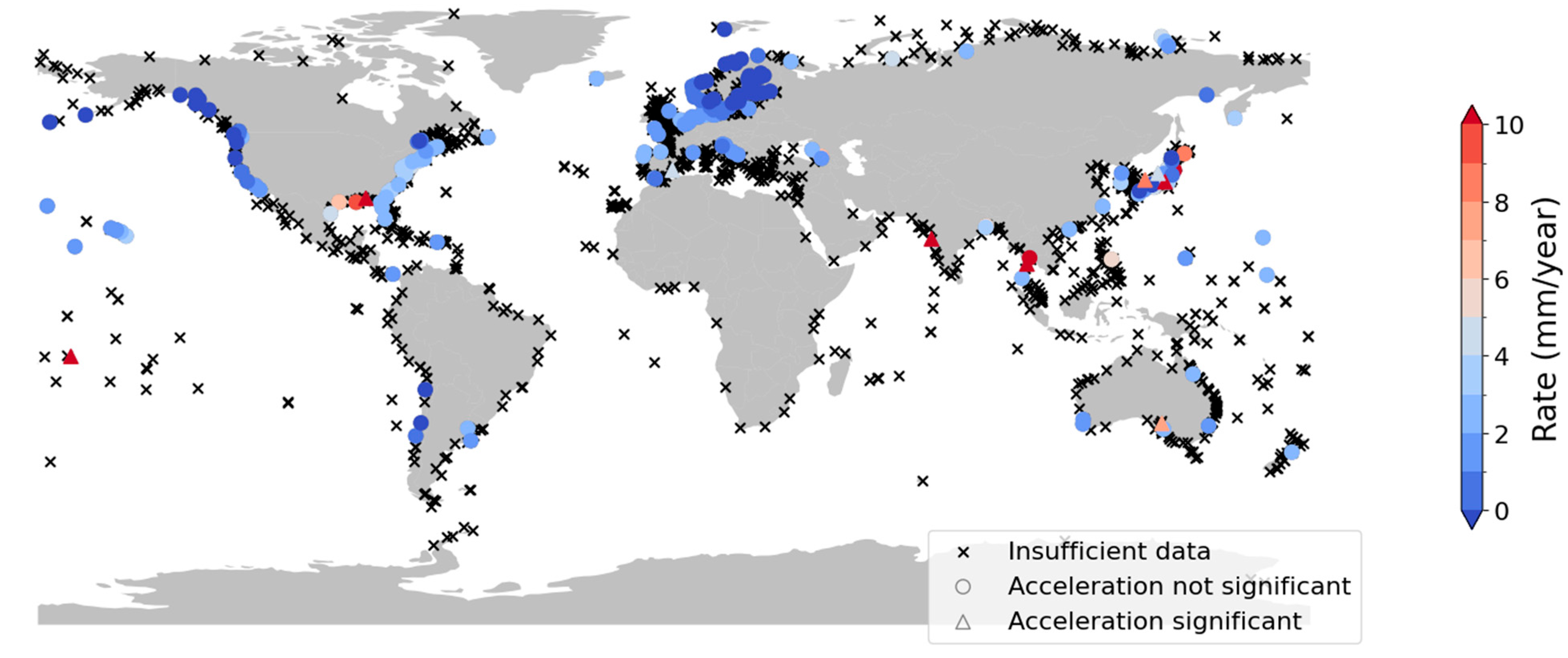


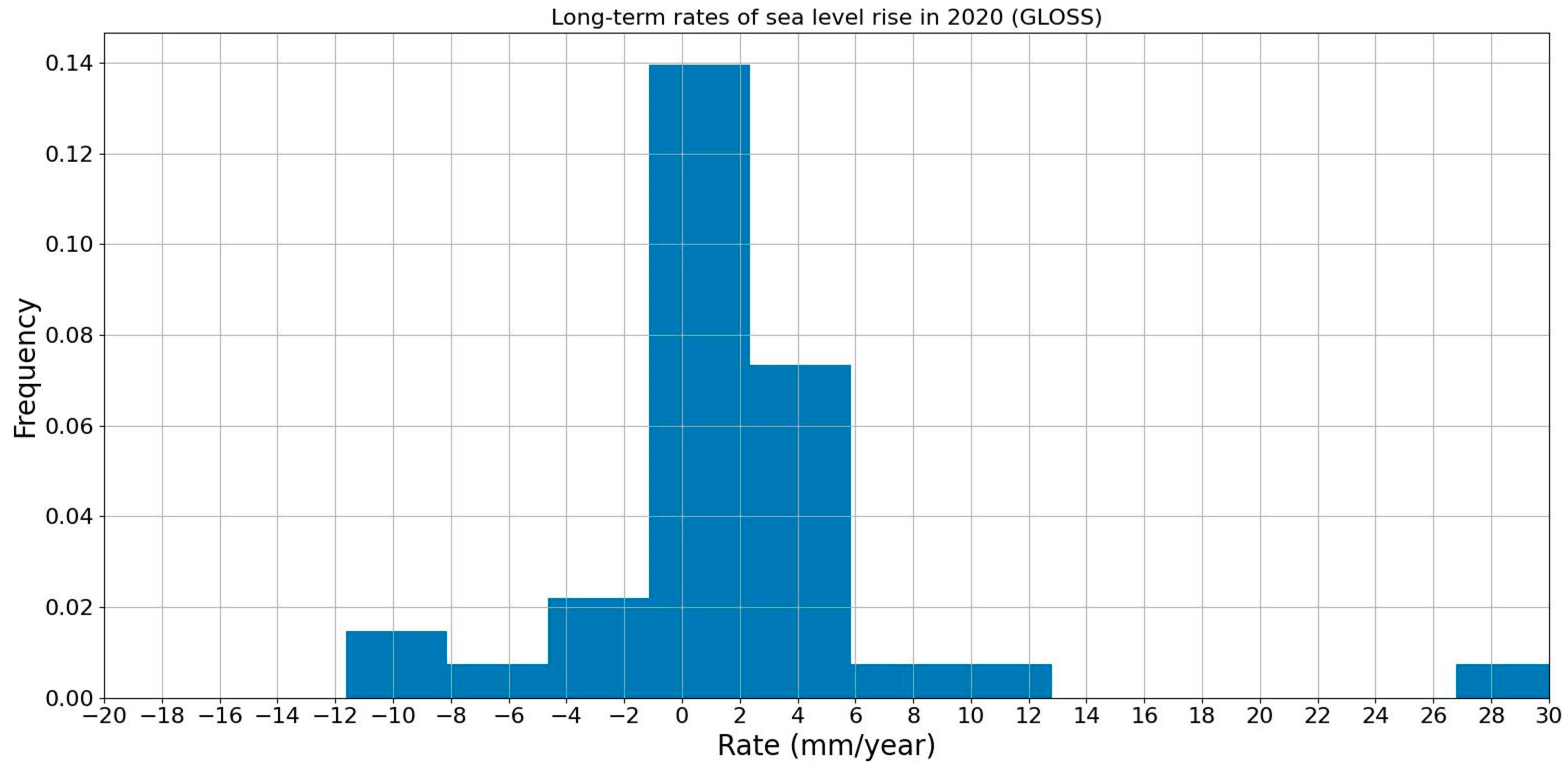

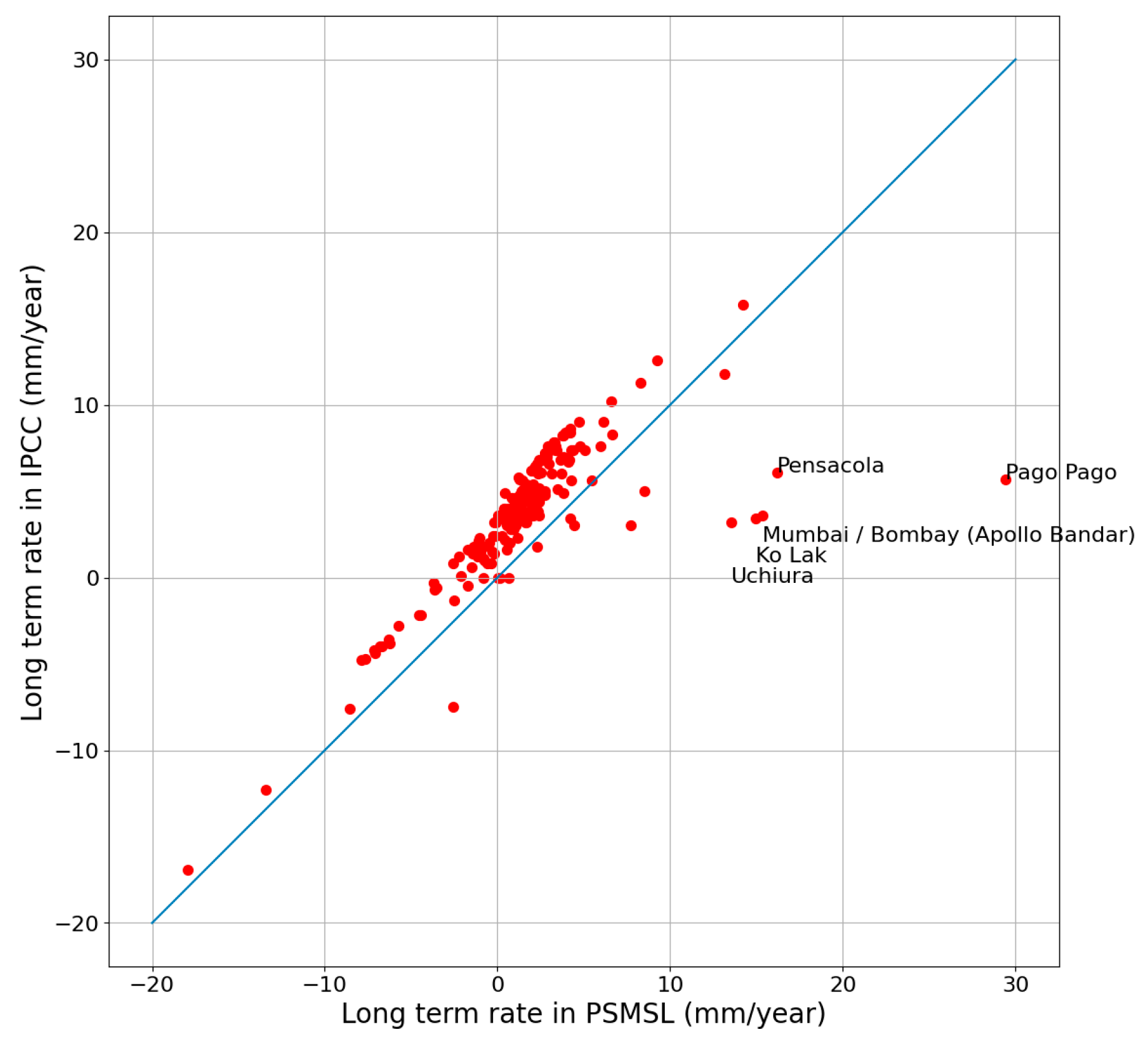
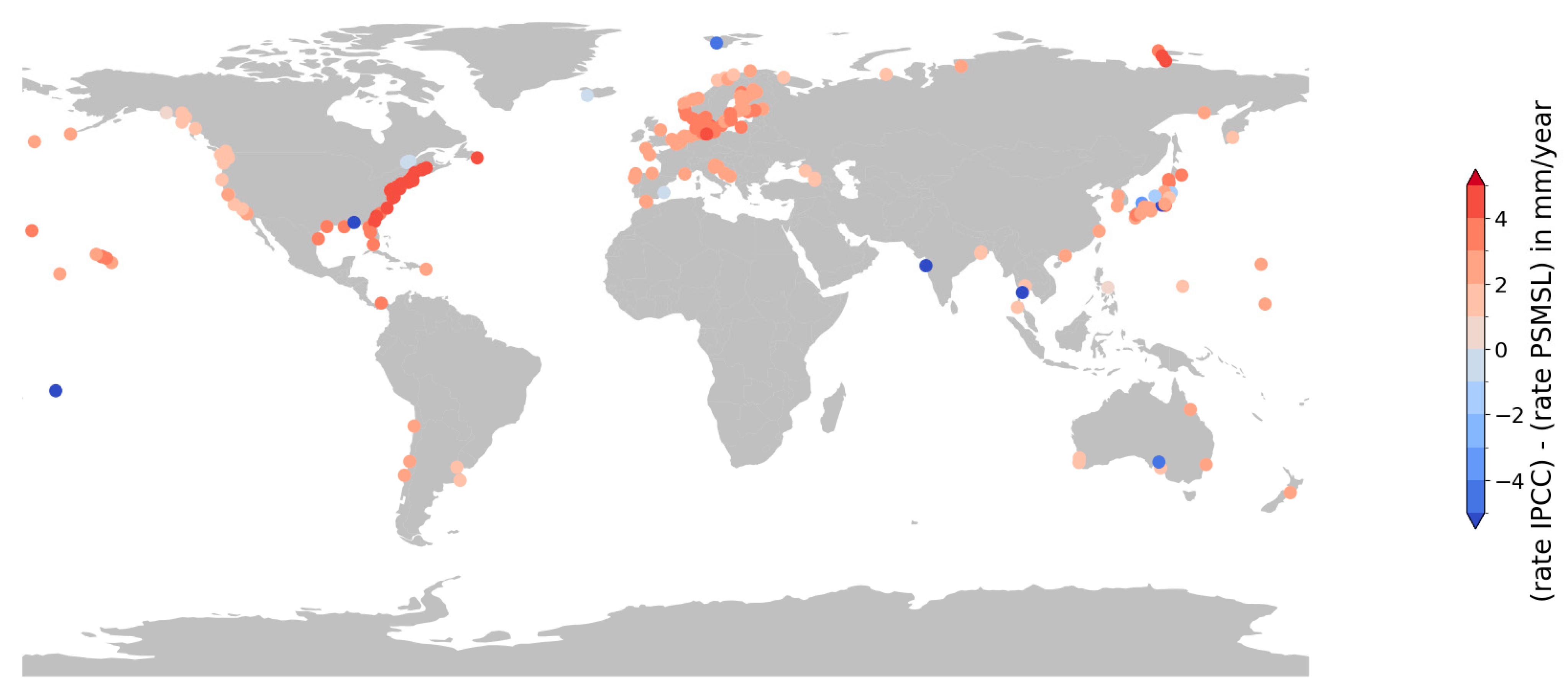
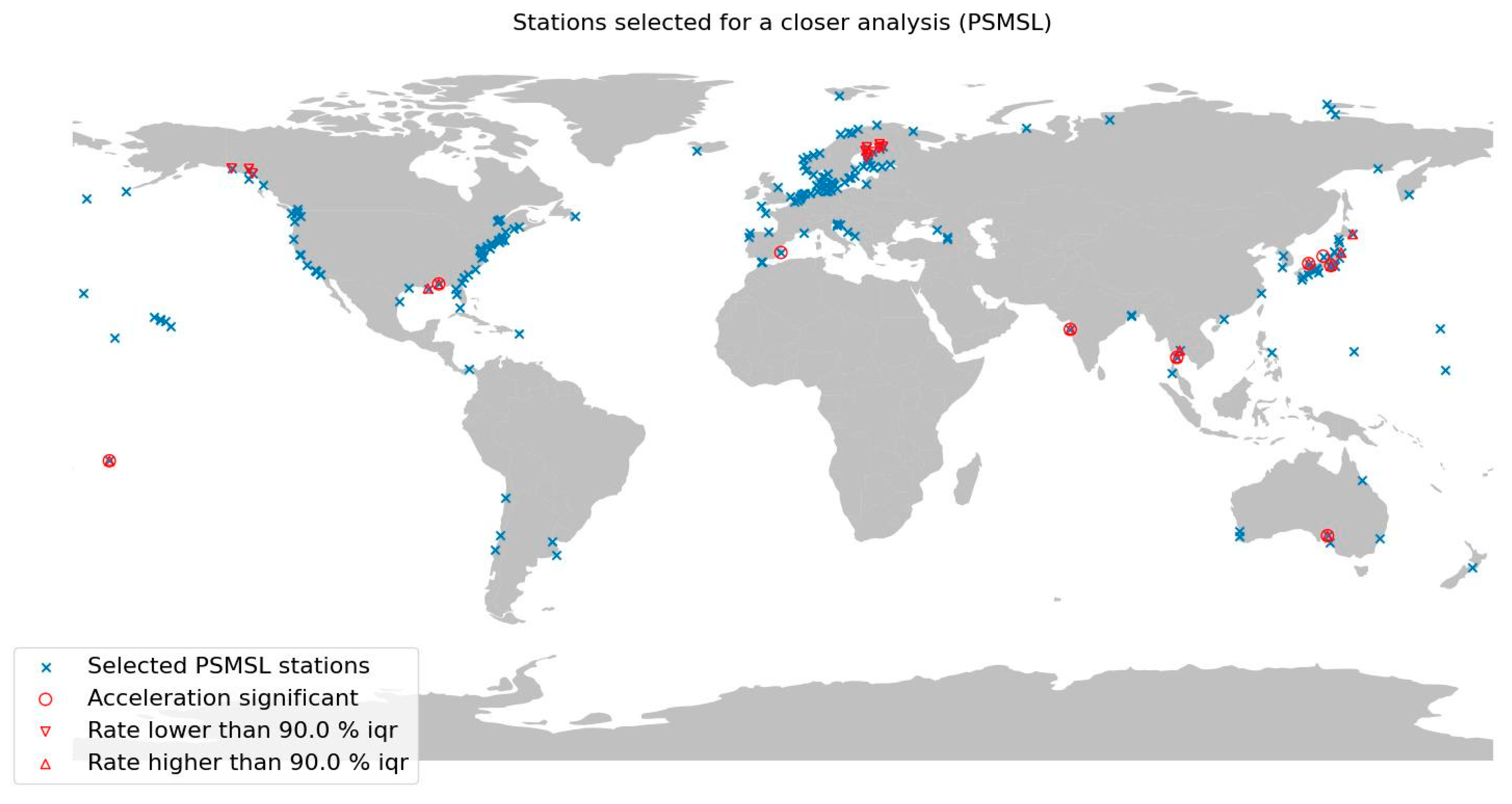
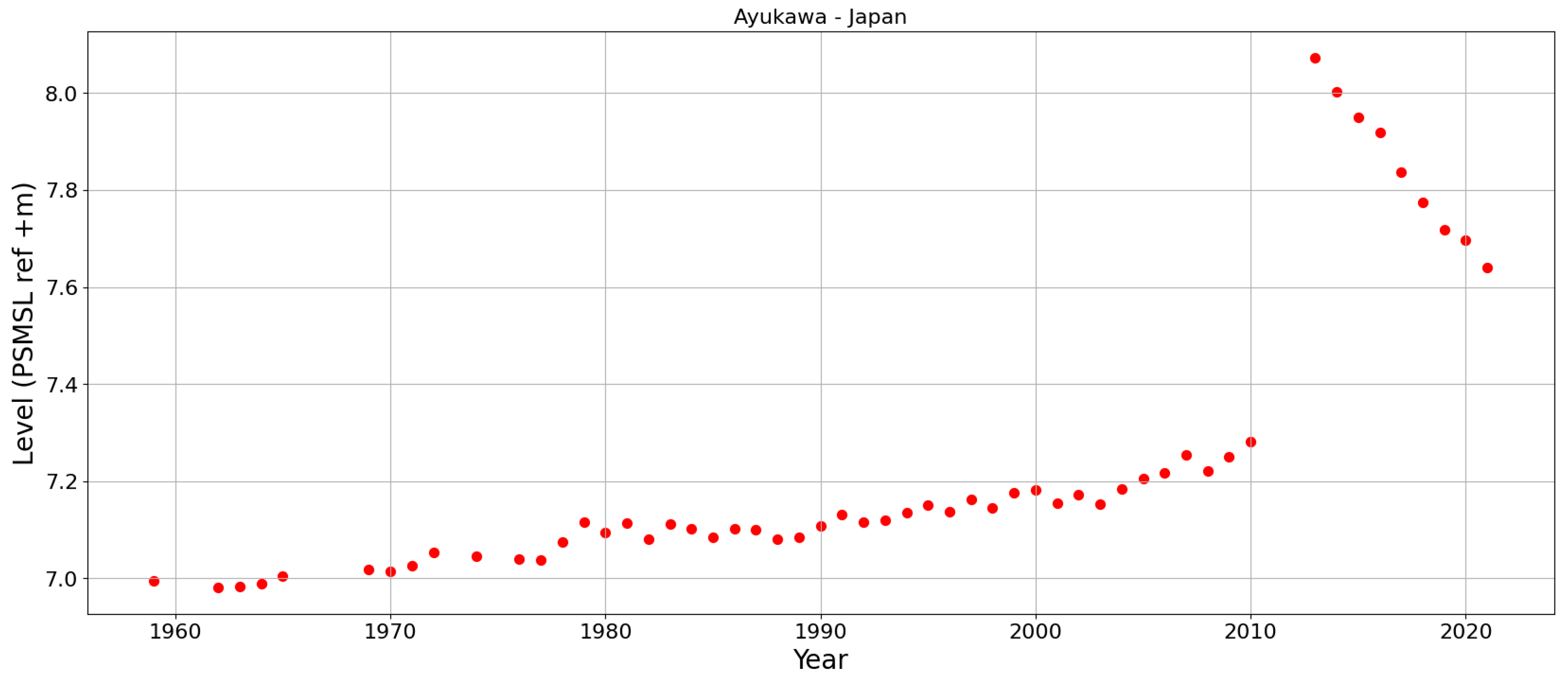
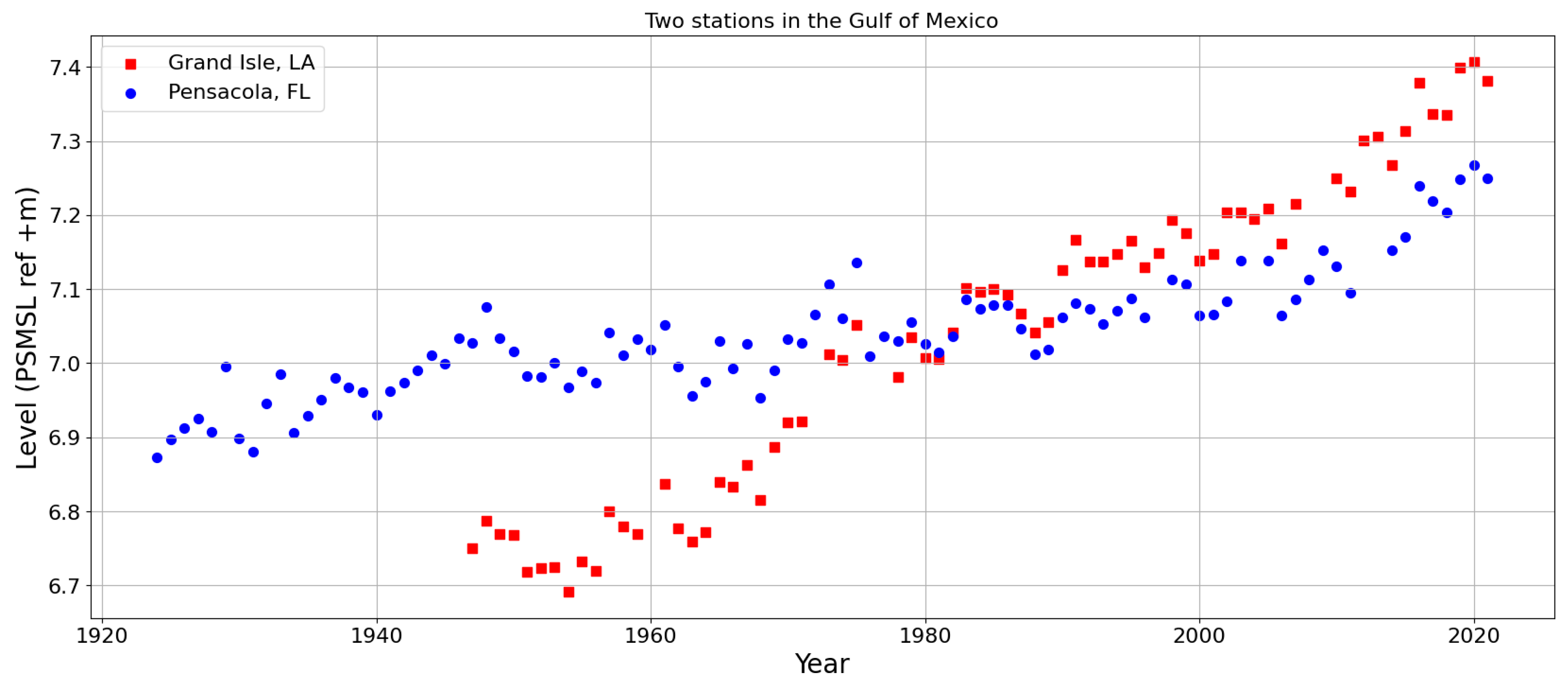
| Cluster | PSMSL Id | Name | Acceleration? | Extreme Rate? | Probable Cause of Observed Sea Level Signal |
|---|---|---|---|---|---|
| Alaska | 495 | Skagway | No | Low | GIA+short-term local rise [107,108] |
| Alaska | 445 | Yakutat | No | Low | GIA+short-term local rise [107,108] |
| Alaska | 405 | Juneau | No | Low | GIA+short-term local rise [107,108] |
| Australia | 216 | Port Pirie | Yes | High | Instrumentation + platform |
| India | 43 | Mumbai/Bombay (Apollo Bandar) | Yes | High | Drainage [109,110] |
| Japan | 518 | Kushiro | No | High | Tectonic, subsidence [111,112] |
| Japan | 131 | Ayukawa | No | High | Tectonic, subsidence [111,112] |
| Japan | 132 | Wajima | Yes | No | Tectonic, subsidence [111,112] |
| Japan | 407 | Uchiura | Yes | High | Tectonic, subsidence [111,112] |
| Japan | 811 | Sakai | Yes | High | Tectonic, subsidence [111,112] |
| Gulf of Mexico | 526 | Grand Isle | No | High | GIA+tectonic. subsidence+sediment load [113,114,115] |
| Gulf of Mexico | 246 | Pensacola | Yes | High | GIA+tectonic, subsidence+sediment load [113,114,115] |
| Samoa | 539 | Pago Pago | Yes | High | Tectonic, subsidence [116] |
| Scandinavia | 240 | Raahe/Brahestad | No | Low | GIA [117] |
| Scandinavia | 229 | Kemi | No | Low | GIA [117] |
| Scandinavia | 203 | Furuogrund | No | Low | GIA [117] |
| Scandinavia | 194 | Pietarsaari/Jakobstad | No | Low | GIA [117] |
| Scandinavia | 88 | Ratan | No | Low | GIA [117] |
| Scandinavia | 79 | Oulu/Uleaborg | No | Low | GIA [117] |
| Scandinavia | 57 | Vaasa/Vasa | No | Low | GIA [117] |
| Scandinavia | 285 | Kaskinen/Kasko | No | Low | GIA [117] |
| Spain | 960 | Alicante 2 | Yes | No | Atmospheric [118] |
| Thailand | 444 | Fort Phrachula Chomklao (Pom Phrachun) | No | High | Drainage + sediment load [119,120,121] |
| Thailand | 174 | Ko Lak | Yes | High | Unclear [122,123] |
Disclaimer/Publisher’s Note: The statements, opinions and data contained in all publications are solely those of the individual author(s) and contributor(s) and not of MDPI and/or the editor(s). MDPI and/or the editor(s) disclaim responsibility for any injury to people or property resulting from any ideas, methods, instructions or products referred to in the content. |
© 2025 by the authors. Licensee MDPI, Basel, Switzerland. This article is an open access article distributed under the terms and conditions of the Creative Commons Attribution (CC BY) license (https://creativecommons.org/licenses/by/4.0/).
Share and Cite
Voortman, H.G.; De Vos, R. A Global Perspective on Local Sea Level Changes. J. Mar. Sci. Eng. 2025, 13, 1641. https://doi.org/10.3390/jmse13091641
Voortman HG, De Vos R. A Global Perspective on Local Sea Level Changes. Journal of Marine Science and Engineering. 2025; 13(9):1641. https://doi.org/10.3390/jmse13091641
Chicago/Turabian StyleVoortman, Hessel G., and Rob De Vos. 2025. "A Global Perspective on Local Sea Level Changes" Journal of Marine Science and Engineering 13, no. 9: 1641. https://doi.org/10.3390/jmse13091641
APA StyleVoortman, H. G., & De Vos, R. (2025). A Global Perspective on Local Sea Level Changes. Journal of Marine Science and Engineering, 13(9), 1641. https://doi.org/10.3390/jmse13091641








